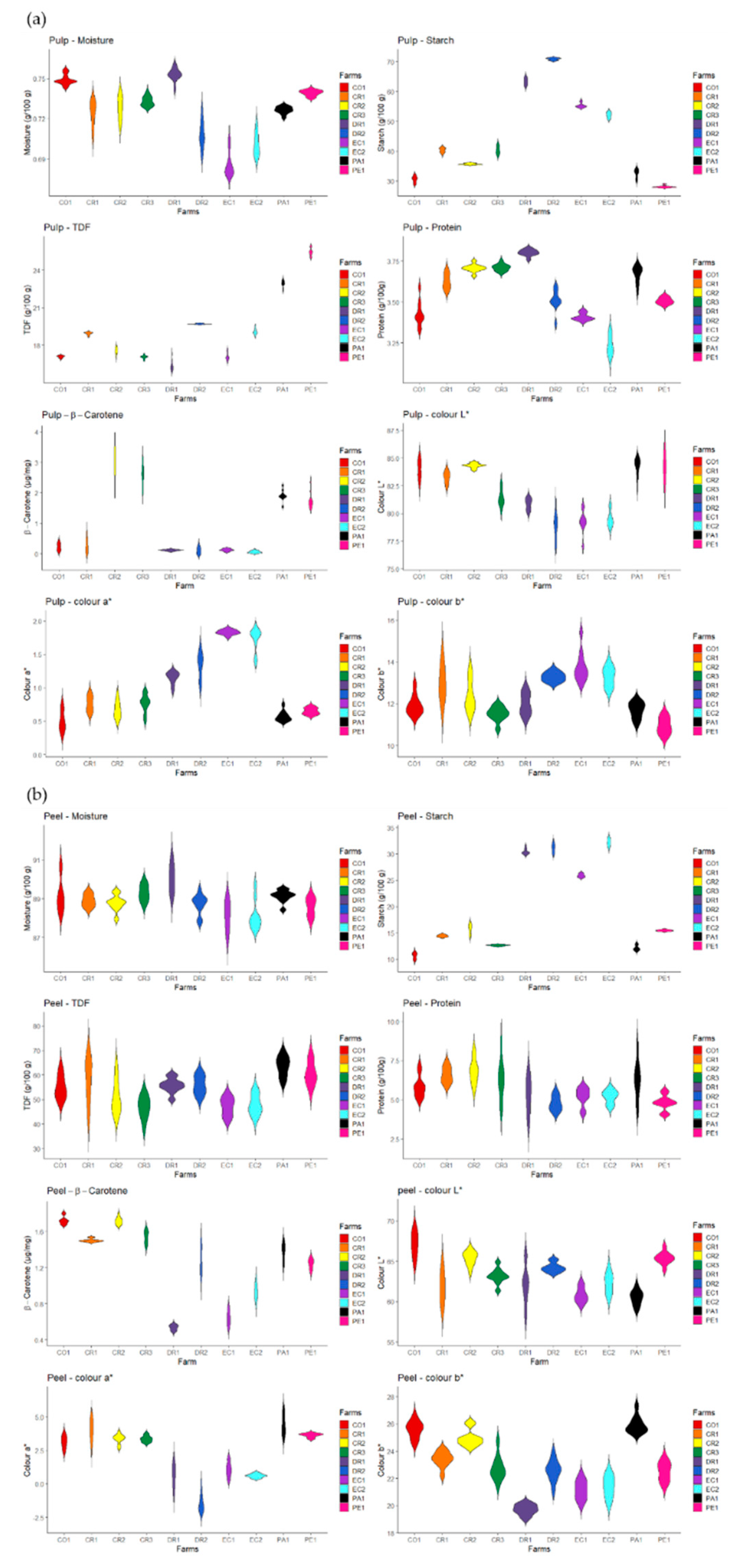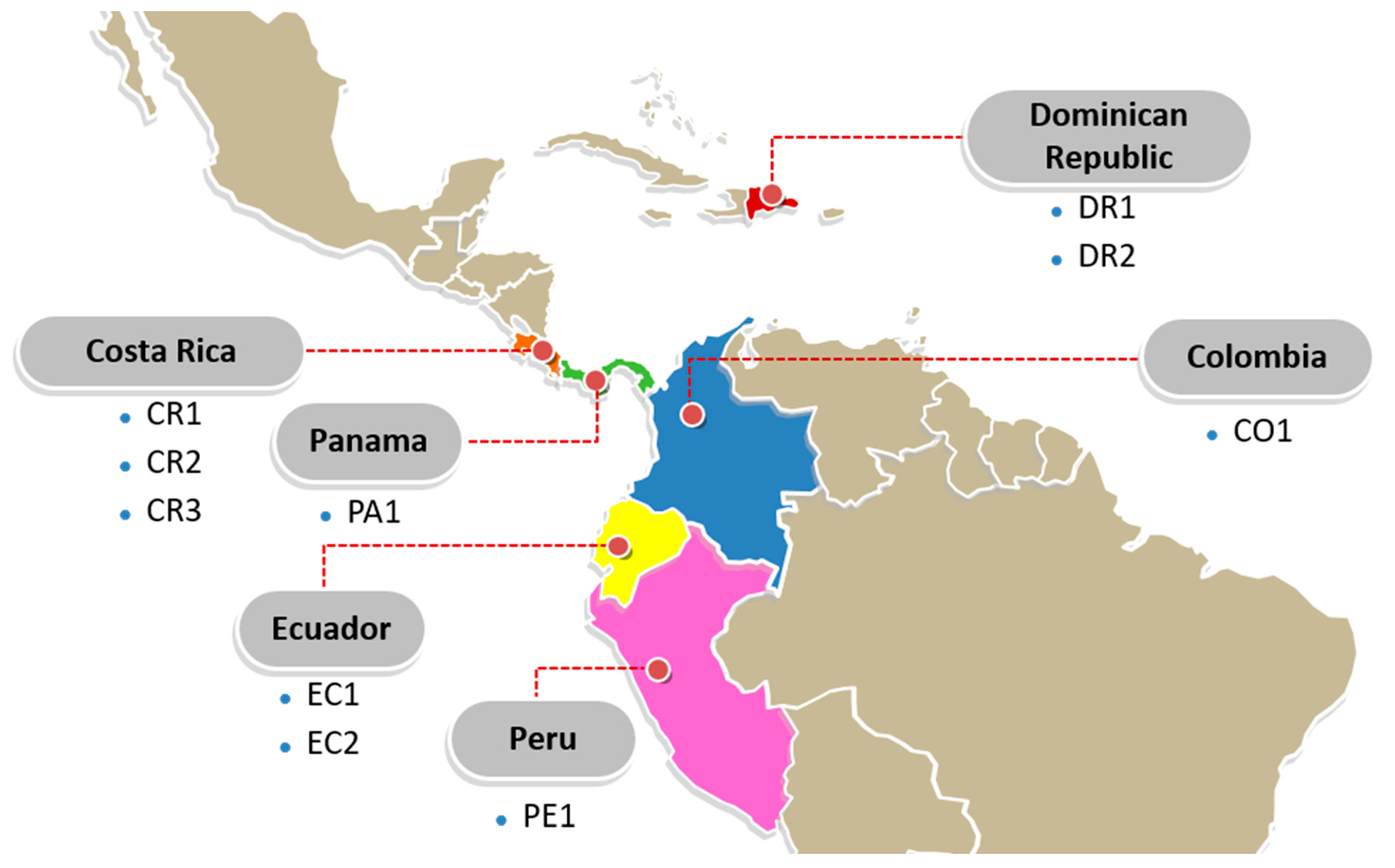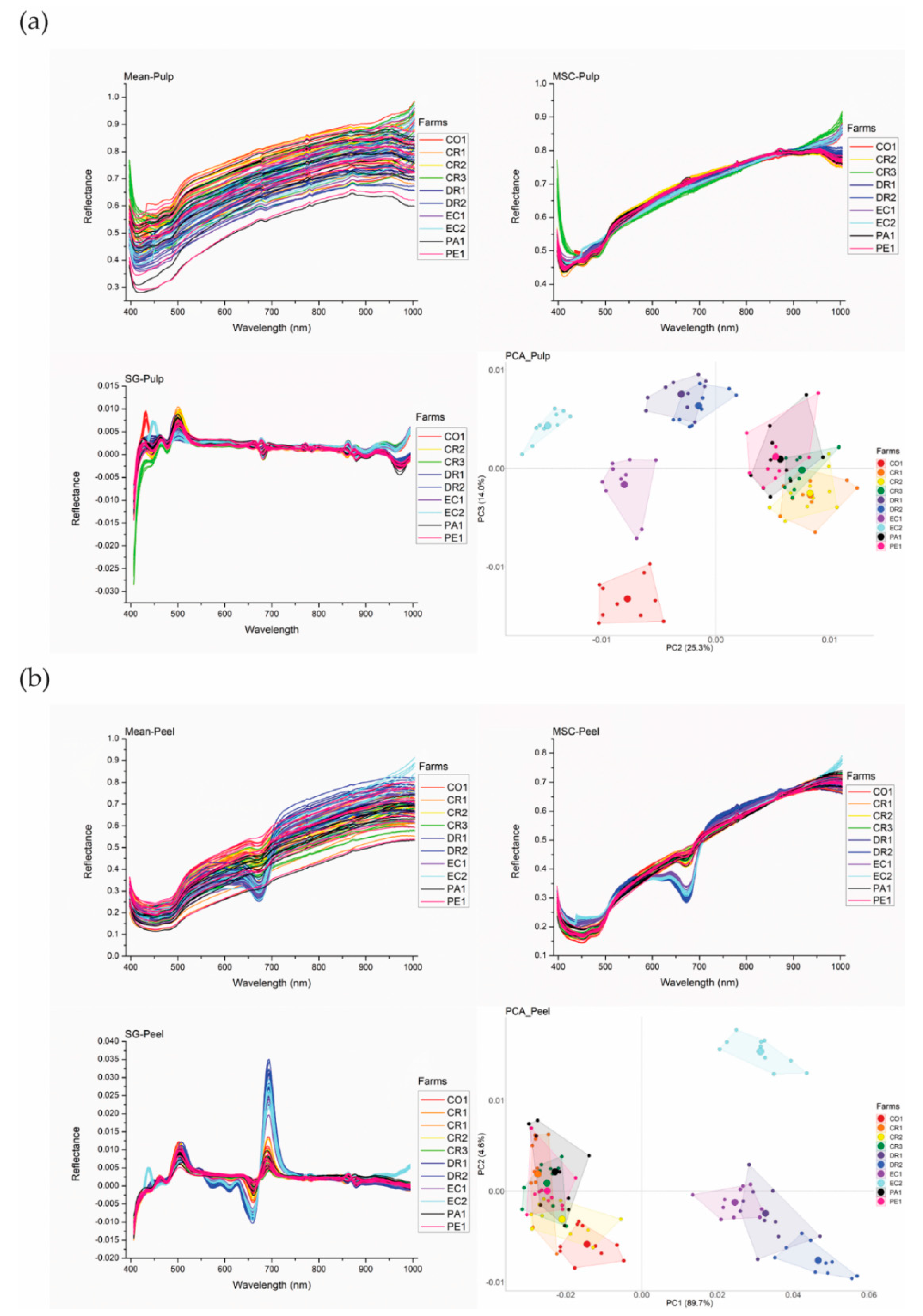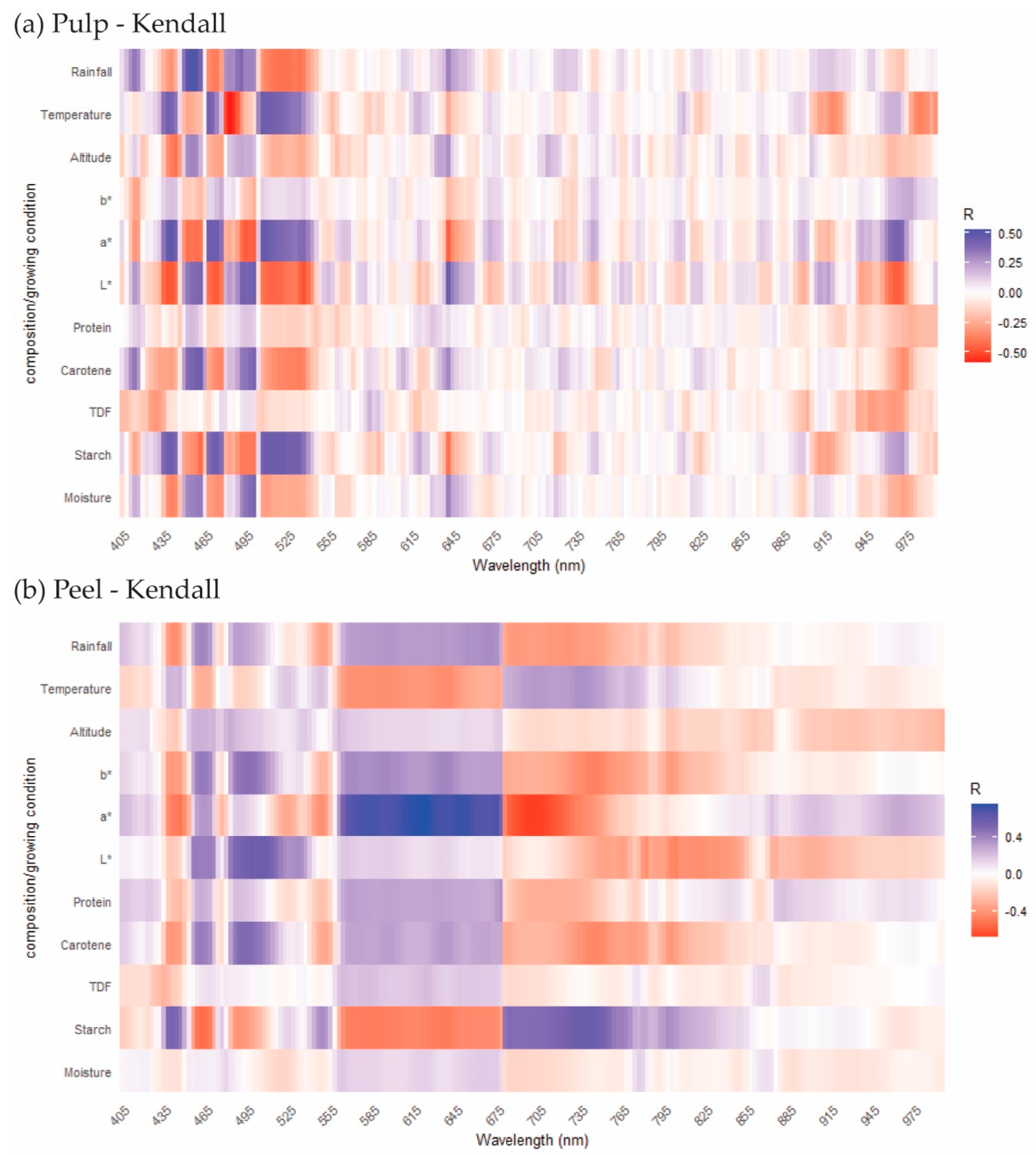Study on the Relations between Hyperspectral Images of Bananas (Musa spp.) from Different Countries, Their Compositional Traits and Growing Conditions
Abstract
:1. Introduction
2. Materials and Methods
2.1. Sample Collection and Preparation
2.2. Geographical Data
2.3. Hyperspectral Imaging
2.4. Determination of Moisture, Starch, Total Dietary Fibre, Protein and Carotene Contents
2.5. Colour (L*a*b*) Value Measurements
2.6. Statistical Analysis
2.6.1. Data Processing of Hyperspectral Images
2.6.2. Data Analysis of Banana Compositions
3. Results and Discussion
3.1. Explorative Analysis of the Spectral Features, Compositional Traits of Banana Pulp, Peel and Related Growing Conditions
3.2. Correlation of the HSI Spectra, Compositional Traits Colour Data and Growing Conditions
3.3. Correlation between Growing Conditions and Banana Composition
4. Conclusions
Author Contributions
Funding
Acknowledgments
Conflicts of Interest
Appendix A

References
- Pereira, A.; Maraschin, M. Banana (Musa spp.) from peel to pulp: Ethnopharmacology, source of bioactive compounds and its relevance for human health. J. Ethnopharmacol. 2015, 160, 149–163. [Google Scholar] [CrossRef] [PubMed]
- Singh, B.; Singh, J.P.; Kaur, A.; Singh, N. Bioactive compounds in banana and their associated health benefits—A review. Food Chem. 2016, 206, 1–11. [Google Scholar] [CrossRef] [PubMed]
- Sulaiman, S.F.; Yusoff, N.A.M.; Eldeen, I.M.; Seow, E.M.; Sajak, A.A.B.; Ooi, K.L. Correlation between total phenolic and mineral contents with antioxidant activity of eight Malaysian bananas (Musa sp.). J. Food Compos. Anal. 2011, 24, 1–10. [Google Scholar] [CrossRef]
- Aurore, G.; Parfait, B.; Fahrasmane, L. Bananas, raw materials for making processed food products. Trends Food Sci. Technol. 2009, 20, 78–91. [Google Scholar] [CrossRef]
- Margraf, T.; Santos, É.N.T.; de Andrade, E.F.; van Ruth, S.M.; Granato, D. Effects of geographical origin, variety and farming system on the chemical markers and in vitro antioxidant capacity of Brazilian purple grape juices. Food Res. Int. 2016, 82, 145–155. [Google Scholar] [CrossRef]
- Ben Ghorbal, A.; Leventdurur, S.; Agirman, B.; Boyaci Gunduz, C.P.; Kelebek, H.; Carsanba, E.; Darici, M.; Erten, H. Influence of geographic origin on agronomic traits and phenolic content of cv. Gemlik olive fruits. J. Food Compos. Anal. 2018, 74, 1–9. [Google Scholar] [CrossRef]
- Li, X.; Wasila, H.; Liu, L.; Yuan, T.; Gao, Z.; Zhao, B.; Ahmad, I. Physicochemical characteristics, polyphenol compositions and antioxidant potential of pomegranate juices from 10 Chinese cultivars and the environmental factors analysis. Food Chem. 2015, 175, 575–584. [Google Scholar] [CrossRef]
- Drappier, J.; Thibon, C.; Rabot, A.; Geny Denis, L. Relationship between wine composition and temperature: Impact on Bordeaux wine typicity in the context of global warming—Review. Crit. Rev. Food Sci. Nutr. 2019, 59, 14–30. [Google Scholar] [CrossRef]
- Stewart, A.L.; Ahmed, S. Effects of climate change on fruit nutrition. In Fruit Crops; Srivastava, A.K., Hu, C.B.T.F.C., Eds.; Elsevier: Amsterdam, The Netherlands, 2020; pp. 77–93. ISBN 978-0-12-818732-6. [Google Scholar]
- Fu, X.; Cheng, S.; Liao, Y.; Huang, B.; Du, B.; Zeng, W.; Jiang, Y.; Duan, X.; Yang, Z. Comparative analysis of pigments in red and yellow banana fruit. Food Chem. 2018, 239, 1009–1018. [Google Scholar] [CrossRef]
- FAO. Banana Market. Review: Preliminary Results for 2018; FAO: Roma, Italy, 2019. [Google Scholar]
- Medina, S.; Perestrelo, R.; Silva, P.; Pereira, J.A.M.; Câmara, J.S. Current trends and recent advances on food authenticity technologies and chemometric approaches. Trends Food Sci. Technol. 2019, 85, 163–176. [Google Scholar] [CrossRef]
- Li, L.; Xie, S.; Ning, J.; Chen, Q.; Zhang, Z. Evaluating green tea quality based on multisensor data fusion combining hyperspectral imaging and olfactory visualization systems. J. Sci. Food Agric. 2019, 99, 1787–1794. [Google Scholar] [CrossRef] [PubMed]
- Xu, J.; Gowen, A.A. Spatial-spectral analysis method using texture features combined with PCA for information extraction in hyperspectral images. J. Chemom. 2019, 34, e3132. [Google Scholar] [CrossRef]
- Oliveira, M.M.; Cruz Tirado, J.P.; Barbin, D.F. Nontargeted analytical methods as a powerful tool for the authentication of spices and herbs: A review. Compr. Rev. Food Sci. Food Saf. 2019, 18, 670–689. [Google Scholar] [CrossRef] [Green Version]
- Acierno, V.; Fasciani, G.; Kiani, S.; Caligiani, A.; van Ruth, S. PTR-QiToF-MS and HSI for the characterization of fermented cocoa beans from different origins. Food Chem. 2019, 289, 591–602. [Google Scholar] [CrossRef]
- Sun, J.; Lu, X.; Mao, H.; Jin, X.; Wu, X. A Method for rapid identification of rice origin by hyperspectral imaging technology. J. Food Process. Eng. 2017, 40, e12297. [Google Scholar] [CrossRef] [Green Version]
- Choi, J.Y.; Heo, S.; Bae, S.; Kim, J.; Moon, K.D. Discriminating the origin of basil seeds (Ocimum basilicum L.) using hyperspectral imaging analysis. LWT 2020, 118, 108715. [Google Scholar] [CrossRef]
- Mditshwa, A.; Magwaza, L.S.; Tesfay, S.Z.; Mbili, N. Postharvest quality and composition of organically and conventionally produced fruits: A review. Sci. Hortic. 2017, 216, 148–159. [Google Scholar] [CrossRef]
- Latin America Map Free Templates. Available online: www.Yourfreetemplates.com/ (accessed on 2 June 2016).
- Harris, I.C.; Jones, P.D.; Osborn, T. (2020): CRU TS4.04: Climatic Research Unit (CRU) Time-Series (TS) version 4.04 of high-resolution gridded data of month-by-month variation in climate (Jan. 1901- Dec. 2019). Centre for Environmental Data Analysis. Available online: https://catalogue.ceda.ac.uk/uuid/89e1e34ec3554dc98594a5732622bce9 (accessed on 12 October 2020).
- Behmann, J.; Acebron, K.; Emin, D.; Bennertz, S.; Matsubara, S.; Thomas, S.; Bohnenkamp, D.; Kuska, M.; Jussila, J.; Salo, H.; et al. Specim IQ: Evaluation of a new, miniaturized handheld hyperspectral camera and its application for plant phenotyping and disease detection. Sensors 2018, 18, 441. [Google Scholar] [CrossRef] [Green Version]
- Park, B.; Lu, R. Hyperspectral Imaging Technology in Food and Agriculture; Park, B., Lu, R., Eds.; Food Engineering Series; Springer: New York, NY, USA, 2015; ISBN 978-1-4939-2835-4. [Google Scholar]
- Srichuwong, S.; Curti, D.; Austin, S.; King, R.; Lamothe, L.; Gloria Hernandez, H. Physicochemical properties and starch digestibility of whole grain sorghums, millet, quinoa and amaranth flours, as affected by starch and non-starch constituents. Food Chem. 2017, 233, 1–10. [Google Scholar] [CrossRef]
- Jung, S.; Rickert, D.A.; Deak, N.A.; Aldin, E.D.; Recknor, J.; Johnson, L.A.; Murphy, P.A. Comparison of kjeldahl and dumas methods for determining protein contents of soybean products. J. Am. Oil Chem. Soc. 2003, 80, 1169. [Google Scholar] [CrossRef]
- Ayustaningwarno, F.; van Ginkel, E.; Vitorino, J.; Dekker, M.; Fogliano, V.; Verkerk, R. Nutritional and physicochemical quality of vacuum-fried mango chips is affected by ripening stage, frying temperature, and time. Front. Nutr. 2020, 7. [Google Scholar] [CrossRef]
- Ashwar, B.A.; Gani, A.; Wani, I.A.; Shah, A.; Masoodi, F.A.; Saxena, D.C. Production of resistant starch from rice by dual autoclaving-retrogradation treatment: Invitro digestibility, thermal and structural characterization. Food Hydrocoll. 2016, 56, 108–117. [Google Scholar] [CrossRef]
- Yin, W.; Zhang, C.; Zhu, H.; Zhao, Y.; He, Y. Application of near-infrared hyperspectral imaging to discriminate different geographical origins of Chinese wolfberries. PLoS ONE 2017, 12, e0180534. [Google Scholar] [CrossRef] [Green Version]
- Shapiro, S.S.; Wilk, M.B. An Analysis of Variance Test for Normality (Complete Samples). Biometrika 1965, 52, 591. [Google Scholar] [CrossRef]
- Gao, J.; Li, X.; Zhu, F.; He, Y. Application of hyperspectral imaging technology to discriminate different geographical origins of Jatropha curcas L. seeds. Comput. Electron. Agric. 2013, 99, 186–193. [Google Scholar] [CrossRef]
- Bugaud, C.; Chillet, M.; Beauté, M.P.; Dubois, C. Physicochemical analysis of mountain bananas from the French West Indies. Sci. Hortic. 2006, 108, 167–172. [Google Scholar] [CrossRef]
- Workman, J., Jr.; Weyer, L. Practical Guide to Interpretive Near-Infrared Spectroscopy; CRC Press: Boca Raton, FL, USA, 2007; ISBN 9780429119576. [Google Scholar]
- Emaga, T.H.; Bindelle, J.; Agneesens, R.; Buldgen, A.; Wathelet, B.; Paquot, M. Ripening influences banana and plantain peels composition and energy content. Trop. Anim. Health Prod. 2011, 43, 171–177. [Google Scholar] [CrossRef] [PubMed]
- Pareek, S. Nutritional and Biochemical Composition of Banana (Musa spp.) Cultivars. In Nutritional Composition of Fruit Cultivars; Academic Press: Cambridge, MA, USA, 2015; ISBN 9780124081178. [Google Scholar]
- Sun, D.; Weng, H.; He, X.; Li, L.; He, Y.; Cen, H. Combining near-infrared hyperspectral imaging with elemental and isotopic analysis to discriminate farm-raised pacific white shrimp from high-salinity and low-salinity environments. Food Chem. 2019, 299, 125121. [Google Scholar] [CrossRef] [PubMed]
- Bugaud, C.; Daribo, M.O.; Dubois, C. Climatic conditions affect the texture and colour of Cavendish bananas (Grande Naine cultivar). Sci. Hortic. 2007, 113, 238–243. [Google Scholar] [CrossRef]
- Yang, X.; Song, J.; Fillmore, S.; Pang, X.; Zhang, Z. Effect of high temperature on color, chlorophyll fluorescence and volatile biosynthesis in green-ripe banana fruit. Postharvest Biol. Technol. 2011, 62, 246–257. [Google Scholar] [CrossRef]
- Cardoso, P.C.; Tomazini, A.P.B.; Stringheta, P.C.; Ribeiro, S.M.R.; Pinheiro Sant’Ana, H.M. Vitamin C and carotenoids in organic and conventional fruits grown in Brazil. Food Chem. 2011, 126, 411–416. [Google Scholar] [CrossRef] [Green Version]
- Reche, J.; Hernández, F.; Almansa, M.S.; Carbonell-Barrachina, Á.A.; Legua, P.; Amorós, A. Effects of organic and conventional farming on the physicochemical and functional properties of jujube fruit. LWT 2019, 99, 438–444. [Google Scholar] [CrossRef]
- Bunea, C.I.; Pop, N.; Babeş, A.C.; Matea, C.; Dulf, F.V.; Bunea, A. Carotenoids, total polyphenols and antioxidant activity of grapes (Vitis vinifera) cultivated in organic and conventional systems. Chem. Cent. J. 2012, 6, 66. [Google Scholar] [CrossRef] [PubMed] [Green Version]
- Brodziak, A.; Król, J.; Litwińczuk, Z.; Barłowska, J. Differences in bioactive protein and vitamin status of milk from certified organic and conventional farms. Int. J. Dairy Technol. 2018, 71, 321–332. [Google Scholar] [CrossRef]
- Su, W.; Sun, D. Potential of hyperspectral imaging for visual authentication of sliced organic potatoes from potato and sweet potato tubers and rapid grading of the tubers according to moisture proportion. Comput. Electron. Agric. 2016, 125, 113–124. [Google Scholar] [CrossRef]
- Boudhrioua, N.; Giampaoli, P.; Bonazzi, C. Changes in aromatic components of banana during ripening and air-drying. LWT Food Sci. Technol. 2003, 36, 633–642. [Google Scholar] [CrossRef]
- Nguyen, M.H.; Price, W.E. Air-drying of banana: Influence of experimental parameters, slab thickness, banana maturity and harvesting season. J. Food Eng. 2007, 79, 200–207. [Google Scholar] [CrossRef] [Green Version]
- Lei, Y.; Zhou, Q.; Zhang, Y.; Chen, J.; Sun, S.; Noda, I. Analysis of crystallized lactose in milk powder by Fourier-transform infrared spectroscopy combined with two-dimensional correlation infrared spectroscopy. J. Mol. Struct. 2010, 974, 88–93. [Google Scholar] [CrossRef]
- Mohapatra, D.; Mishra, S.; Sutar, N. Banana and its by-product utilisation: An overview. J. Sci. Ind. Res. 2010, 69, 323–329. [Google Scholar]
- Lima, G.P.P.; Vianello, F. Review on the main differences between organic and conventional plant-based foods. Int. J. Food Sci. Technol. 2011, 46, 1–13. [Google Scholar] [CrossRef]
- Pu, H.; Lin, L.; Sun, D. Principles of hyperspectral microscope imaging techniques and their applications in food quality and safety detection: A review. Compr. Rev. Food Sci. Food Saf. 2019, 18, 853–866. [Google Scholar] [CrossRef] [Green Version]
- Ørnholt Johansson, G.; Frosch, S.; Munk Jørgensen, B. Variation in some quality attributes of Atlantic salmon fillets from aquaculture related to geographic origin and water temperature. Aquaculture 2017, 479, 378–383. [Google Scholar] [CrossRef]
- Manach, C.; Scalbert, A.; Morand, C.; Rémésy, C.; Jiménez, L. Polyphenols: Food sources and bioavailability. Am. J. Clin. Nutr. 2004, 79, 727–747. [Google Scholar] [CrossRef] [PubMed] [Green Version]
- Tumwegamire, S.; Kapinga, R.; Rubaihayo, P.R.; LaBonte, D.R.; Grüneberg, W.J.; Burgos, G.; Felde, T.Z.; Carpio, R.; Pawelzik, E.; Mwanga, R.O.M. Evaluation of Dry Matter, Protein, Starch, Sucrose, β-carotene, Iron, Zinc, Calcium, and Magnesium in East African Sweetpotato [Ipomoea batatas (L.) Lam] Germplasm. HortScience 2011, 46, 348–357. [Google Scholar] [CrossRef]
- Silva, D.M.N.; Lima, R.R.; Oliveira, F.L.; Teixeira, L.J.Q.; Machado, L.C.A. Physical and chemical characterization of yacon tuberous roots at different altitudes and planting times. Hortic. Bras. 2018, 36, 199–204. [Google Scholar] [CrossRef]
- de Jesús Ornelas-Paz, J.; Quintana Gallegos, B.M.; Escalante Minakata, P.; Reyes Hernández, J.; Pérez Martínez, J.D.; Rios Velasco, C.; Ruiz Cruz, S. Relationship between the firmness of Golden Delicious apples and the physicochemical characteristics of the fruits and their pectin during development and ripening. J. Food Sci. Technol. 2018, 55, 33–41. [Google Scholar] [CrossRef] [PubMed]
- Sulaeman, A.; Keeler, L.; Giraud, D.W.; Taylor, S.L.; Wehling, R.L.; Driskell, J.A. Carotenoid content and physicochemical and sensory characteristics of carrot chips deep-fried in different oils at several temperatures. J. Food Sci. 2001, 66, 1257–1264. [Google Scholar] [CrossRef]
- Sim, I.; Suh, D.H.; Singh, D.; Do, S.G.; Moon, K.H.; Lee, J.H.; Ku, K.M.; Lee, C.H. Unraveling metabolic variation for blueberry and chokeberry cultivars harvested from different geo-climatic regions in Korea. J. Agric. Food Chem. 2017, 65, 9031–9040. [Google Scholar] [CrossRef]
- Cao, T.; Liu, J.; Zhang, X.; Wei, X.; Qi, Y.; Zhang, B.; Liu, H.; Xiao, P. Metabolomics characterization of different geographical origins of Flos Carthami using UPLC-QTOF/MS and their correlation with climate factors. Anal. Methods 2019, 11, 2700–2711. [Google Scholar] [CrossRef]
- Mphahlele, R.R.; Caleb, O.J.; Fawole, O.A.; Opara, U.L. Effects of different maturity stages and growing locations on changes in chemical, biochemical and aroma volatile composition of ‘Wonderful’ pomegranate juice. J. Sci. Food Agric. 2016, 96, 1002–1009. [Google Scholar] [CrossRef]
- Tuberoso, C.I.G.; Jerković, I.; Sarais, G.; Congiu, F.; Marijanović, Z.; Kuś, P.M. Color evaluation of seventeen European unifloral honey types by means of spectrophotometrically determined CIE chromaticity coordinates. Food Chem. 2014, 145, 284–291. [Google Scholar] [CrossRef] [PubMed]





| Country | Farm Code | Pulp | Peel | Production System | Altitude (m) | Monthly Mean Temperature (°C) | Annual Rainfall (mm/year) |
|---|---|---|---|---|---|---|---|
| Colombia | CO1 | 10 | 10 | Conventional | 66 | 23.2 | 1837 |
| Costa Rica | CR1 | 10 | 10 | Conventional | 726 | 23.4 | 2857 |
| CR2 | 10 | 10 | Conventional | 47 | 24.4 | 5014 | |
| CR3 | 10 | 10 | Conventional | 24 | 26.3 | 4378 | |
| Dominica Republic | DR1 | 10 | 10 | Organic | 65 | 26.7 | 925 |
| DR2 | 10 | 10 | Organic | 27 | 26.7 | 925 | |
| Ecuador | EC1 | 10 | 10 | Organic | 32 | 22.9 | 1511 |
| EC2 | 10 | 10 | Conventional | 22 | 26.5 | 843 | |
| Panama | PA1 | 10 | 10 | Conventional | 10 | 19.7 | 3679 |
| Peru | PE1 | 10 | 10 | Organic | 40 | 24.1 | 200 |
| Country | Farm Code | Production System | Moisture # (g/100 g) | Starch (g/100 g) | Total Dietary Fibre (g/100 g) | Protein (g/100 g) | β-Carotene (μg/mg) | L* | a* | b* |
|---|---|---|---|---|---|---|---|---|---|---|
| Colombia | CO1 | Conventional | 74.8 ab ± 1.7 | 31.4 d ± 5.5 | 17.6 bd ± 1.8 | 3.4 ab ± 0.3 | 0.2 d ± 0.1 | 83.8 a ± 0.6 | 0.4 b ± 0.2 | 12.1 a ± 0.5 |
| Costa Rica | CR1 | Conventional | 72.4 bc ± 0.8 | 41.0 cd ± 4.1 | 19.4 bc ± 1.9 | 3.6 ab ± 0.3 | 0.2 d ± 0.2 | 83.5 a ± 0.7 | 0.7 ab ± 0.1 | 13.1 b ± 0.8 |
| CR2 | Conventional | 72.8 ac ± 0.7 | 36.4 d ± 1.5 | 17.5 bd ± 2.7 | 3.7 ab ± 0.3 | 3.0 a ± 0.4 | 84.1 a ± 0.4 | 0.7 b ± 0.1 | 12.5 a ± 0.8 | |
| CR3 | Conventional | 73.0 ac ± 1.0 | 40.1 cd ± 5.2 | 17.0 cd ± 1.2 | 3.7 ab ± 0.2 | 2.5 b ± 0.3 | 81.5 b ± 0.8 | 0.7 b ± 0.1 | 11.4 b ± 0.4 | |
| Dominica Republic | DR1 | Organic | 75.3 a ± 5.9 | 62.0 ab ± 4.5 | 16.2 d ± 1.2 | 3.8 a ± 0.5 | 0.1 d ± 0.0 | 80.8 bc ± 0.7 | 1.1 c ± 0.1 | 11.8 d ± 0.5 |
| DR2 | Organic | 70.6 cd ± 1.0 | 70.9 a ± 0.4 | 19.7 b ± 1.75 | 3.5 ab ± 0.4 | 0.1 d ± 0.0 | 78.9 d ± 1.8 | 1.3 d ± 0.2 | 13.2 b ± 0.2 | |
| Ecuador | EC1 | Organic | 68.8 d ± 1.0 | 55.4 b ± 6.8 | 17.0 cd ± 2.0 | 3.4 ab ± 0.7 | 0.1 d ± 0.1 | 79.3 d ± 1.1 | 1.8 c ± 0.2 | 14.1 c ± 0.7 |
| EC2 | Conventional | 69.4 d ± 1.7 | 52.1 bc ± 6.2 | 19.1 bc ± 2.4 | 3.2 ab ± 0.1 | 0.0 d ± 0.0 | 79.7 cd ± 0.9 | 1.6 c ± 0.3 | 13.1 c ± 0.5 | |
| Panama | PA1 | Conventional | 72.6 ac ± 0.3 | 33.4 d ± 2.8 | 22.9 a ± 1.5 | 3.7 ab ± 0.3 | 1.8 c ± 0.2 | 84.1 a ± 0.8 | 0.5 a ± 0.1 | 11.7 a ± 0.3 |
| Peru | PE1 | Organic | 74.0 ab ± 0.4 | 28.8 d ± 4.4 | 25.5 a ± 1.3 | 3.5 ab ±0.2 | 1.9 c ± 0.5 | 84.1 a ± 1.2 | 0.6 ab ± 0.2 | 10.9 b ± 0.3 |
| Country | Farm Code | Production System | Moisture # (g/100 g) | Starch (g/100 g) | Total Dietary Fibre (g/100 g) | Protein (g/100 g) | β-Carotene (μg/mg) | L* | a* | b* |
|---|---|---|---|---|---|---|---|---|---|---|
| Colombia | CO1 | Conventional | 89.2 bd ± 0.7 | 10.9 c ± 2.6 | 55.0 bcd ± 4.7 | 5.8 bd ± 0.7 | 1.7 a ± 0.1 | 67.1 a ± 1.4 | 3.2 b ± 0.5 | 25.7 a ± 0.7 |
| Costa Rica | CR1 | Conventional | 88.9 cd ± 0.3 | 14.5 c ± 1.9 | 58.1 ac ± 8.9 | 6.6 b ± 0.5 | 1.5 ac ± 0.5 | 62.7 bce ± 3.6 | 3.9 ab ± 0.7 | 23.2 b ± 0.6 |
| CR2 | Conventional | 88.6 cd ± 0.9 | 15.7 c ± 1.0 | 51.1 ce ± 6.8 | 6.8 b ± 0.7 | 1.7 a ± 0.1 | 65.6 ab ± 1.0 | 3.4 b ± 0.3 | 24.8 a ± 0.6 | |
| CR3 | Conventional | 89.5 bc ± 0.9 | 12.6 c ± 0.1 | 46.9 ce ± 4.5 | 6.2 bc ± 1.2 | 1.5 ac ± 0.1 | 63.8 bcd ± 1.7 | 3.4 b ± 0.2 | 23.0 b ± 1.1 | |
| Dominica Republic | DR1 | Organic | 90.4 b ± 2.0 | 30.3 ab ± 1.9 | 55.8 bc ± 2.9 | 5.3 cd ± 1.1 | 0.5 c ± 0.1 | 62.0 ce ± 2.2 | 0.6 c ± 0.7 | 19.6 c ± 1.2 |
| DR2 | Organic | 88.4 cd ± 0.8 | 31.7 a ± 1.7 | 55.9 bc ± 8.7 | 4.7 d ± 0.4 | 1.2 ac ± 0.2 | 64.4 ac ± 1.7 | −1.5 d ± 0.6 | 22.6 b ± 0.6 | |
| Ecuador | EC1 | Organic | 88.1 d ± 0.6 | 25.6 b ± 3.2 | 47.1 ce ± 6.7 | 5.2 cd ± 0.5 | 0.6 c ± 0.1 | 60.9 de ± 0.8 | 1.1 c ± 0.5 | 21.1 c ± 0.6 |
| EC2 | Conventional | 88.0 d ± 0.6 | 32.7 a ± 1.9 | 47.9 de ± 9.0 | 5.1 cd ± 0.4 | 0.9 c ± 0.1 | 62.3 ce ± 1.1 | 0.7 c ± 0.5 | 21.3 c ± 0.7 | |
| Panama | PA1 | Conventional | 89.1 bd ± 0.3 | 12.8 c ± 1.8 | 63.6 a ± 6.0 | 6.1 bc ± 0.7 | 1.4 ac ± 0.3 | 60.1 e ± 5.4 | 4.6 a ± 0.7 | 25.0 a ± 1.6 |
| Peru | PE1 | Organic | 88.5 cd ± 0.4 | 15.5 c ± 0.2 | 60.7 ab ± 7.8 | 4.8 d ± 0.4 | 1.2 b ± 0.1 | 65.0 ac ± 2.6 | 3.9 ab ± 0.7 | 22.9 c ± 1.5 |
© 2020 by the authors. Licensee MDPI, Basel, Switzerland. This article is an open access article distributed under the terms and conditions of the Creative Commons Attribution (CC BY) license (http://creativecommons.org/licenses/by/4.0/).
Share and Cite
Wang, Z.; Erasmus, S.W.; Liu, X.; van Ruth, S.M. Study on the Relations between Hyperspectral Images of Bananas (Musa spp.) from Different Countries, Their Compositional Traits and Growing Conditions. Sensors 2020, 20, 5793. https://doi.org/10.3390/s20205793
Wang Z, Erasmus SW, Liu X, van Ruth SM. Study on the Relations between Hyperspectral Images of Bananas (Musa spp.) from Different Countries, Their Compositional Traits and Growing Conditions. Sensors. 2020; 20(20):5793. https://doi.org/10.3390/s20205793
Chicago/Turabian StyleWang, Zhijun, Sara Wilhelmina Erasmus, Xiaotong Liu, and Saskia M. van Ruth. 2020. "Study on the Relations between Hyperspectral Images of Bananas (Musa spp.) from Different Countries, Their Compositional Traits and Growing Conditions" Sensors 20, no. 20: 5793. https://doi.org/10.3390/s20205793
APA StyleWang, Z., Erasmus, S. W., Liu, X., & van Ruth, S. M. (2020). Study on the Relations between Hyperspectral Images of Bananas (Musa spp.) from Different Countries, Their Compositional Traits and Growing Conditions. Sensors, 20(20), 5793. https://doi.org/10.3390/s20205793








